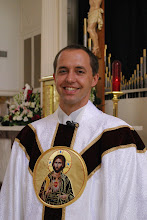
After our welcome to the city, we made our first pilgrim stop in Jerusalem, the Garden of Gethsemane. There are olive trees there estimated to be about 1000 years old but whose roots are likely those of the trees there at the time of Jesus. So, yes, this is what the garden would have looked like. The place where Jesus left Peter, James and John (a stones throw away) was just across the street. Inside the Church of All Nations we celebrated Mass on the altar just behind the stone on which Jesus sweated blood and where the angels ministered to him. This is where he faced a temptation like that of Adam and Eve and stood faithful - he crushed the head of Satan. Here on this spot... Amazing!

Overview:
There are two shrines to consider the Agony of Christ at the Garden of Gethsemane. The first is the cave called the Grotto of Betrayal next to the Tomb of the Blessed Mother. This is the cave where the eight apostles remained while Jesus, Peter, James and John went a “stone’s throw away” (Luke 21:42) to pray as well as the scene of Jesus’ arrest
The second is Garden of Gethsemane, an enclosed grove of olive trees and the Basilica of the Agony or Church of All Nations. A Byzantine church was built in the 4th century with beautiful mosaics but destroyed by the Persians in 614. The Crusaders built another church in 1170. The present church was rebuilt over the Byzantine church in 1925.
THE AGONY (Luke 22:39-53)
Then going out he went, as was his custom, to the Mount of Olives, and the disciples followed him. When he arrived at the place he said to them, "Pray that you may not undergo the test." After withdrawing about a stone's throw from them and kneeling, he prayed, saying, "Father, if you are willing, take this cup away from me; still, not my will but yours be done." (And to strengthen him an angel from heaven appeared to him. He was in such agony and he prayed so fervently that his sweat became like drops of blood falling on the ground.)

After Mass we headed for our Hotel, The Jerusalem Gate, our home for the rest of the trip. It is a Jewish section of the modern city so we encountered the celebration of the end of the Sabbath when we arrived on Saturday evening.









